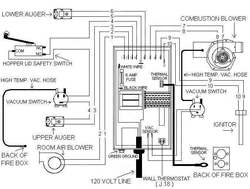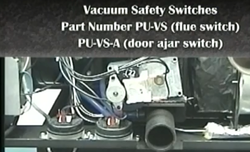The manual I downloaded for my PDVC shows a pressure sensor, but also states it's a generic drawing. My controller board has connectors for one ... but it's been replied with a newer board (also has an unused ignitor connector). I don't see one ... nor where one would mount. Do I just disregard it when troubleshooting, then?
I DO have a temp sensor. Any way to trouble shoot it? Can it's connector be shorted out, to bypass, for testing?
The thermostat connector has such a jumper on it, as we don't have a thermostat, either.
Dennis
I DO have a temp sensor. Any way to trouble shoot it? Can it's connector be shorted out, to bypass, for testing?
The thermostat connector has such a jumper on it, as we don't have a thermostat, either.
Dennis




 I'm pretty sure the exhaust fan is running continuously ... but I'm not so sure about the upper auger. I got a load started .. good burn pot fire, and after 20 minutes I went back down, and fire was about out again, with E 2 on the control panel. Argghhh ...
I'm pretty sure the exhaust fan is running continuously ... but I'm not so sure about the upper auger. I got a load started .. good burn pot fire, and after 20 minutes I went back down, and fire was about out again, with E 2 on the control panel. Argghhh ...